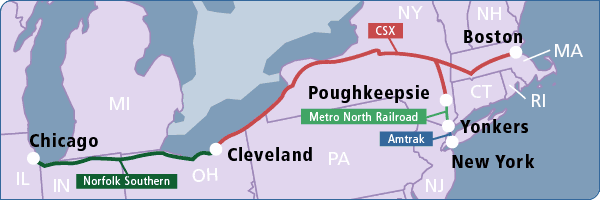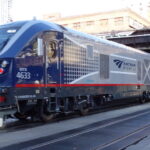Digging Into Amtrak’s OTP Numbers.
An alert reader has pointed out that a relevant bit of information was left out of my last post about Amtrak’s On Time Performance: the official tolerances or wiggle room allowed before any given train is considered to be late. Here they are:
If the route is 250 miles or less, tolerance is 10 minutes.
If the route is 251 to 350 miles, tolerance is 15 minutes.
If the route is 351 to 450 miles, tolerance is 20 minutes.
If the route is 451 to 500 miles, tolerance is 25 minutes.
If the route is 501 miles or more, tolerance is 30 minutes.
So clearly–and, I think, legitimately–the longer the train’s route, the more minutes are allowed before it’s pronounced officially “late”. For example, the Boston-Chicago section of the Lake Shore Limited travels 1,018 miles. If it arrives in Chicago 27 minutes late, it is considered to have arrived on time. If, however, it arrives 34 minutes late, that is considered a late arrival. (I should add here that the airlines have similar tolerances when their OTP is calculated.)
But there’s a catch: while arrival and departure times for Amtrak trains are meticulously recorded at all intermediate station stops, that information is not factored in when determining a train’s overall on time performance.

Here’s an example: the westbound Lake Shore Limited’s scheduled arrival time in Cleveland is 3:30 a.m. The train could arrive 90 minutes late in Cleveland, but make up time because of padding in the schedule and arrive in Chicago at 10:10 a.m., only 25 minutes late. Under the current system, that train on that day would go into the books as running on time. But if you were one of the passengers waiting an additional hour-and-a-half for your train in Cleveland at 3:30 in the morning on that day, I doubt you would agree that the Lake Shore ran on time.
Therein lies the problem: the freight railroads can say they are running Amtrak trains on time—and they are paid extra for doing so—but the schedules are “rigged” to allow for the inevitable delays, most of which are caused by the freight railroads. For some time, NARP (the National Association of Railroad Passengers) has been pressing to have in-and-out times at intermediate stops be part of the equation when determining any given train’s on time record. If that should happen, Amtrak’s numbers would be very different. And the freight railroads would have to stop claiming they are doing such a good job running Amtrak trains on time.




I agree that Amtrak’s schedule padding is out of control and distorts all reality how the schedules are adhered to; as well, questions the legitimate basis for paying a bonus to the Class 1. Up until 5/1/71, you could count on the Santa Fe’s declared timecard of its “Super Chief” in 39.5 hours between Chicago-LA.
Yet, the recent D.C. Circuit Court of Appeals decision against Amtrak setting dispatching/OTP metrics for Class 1s is indicative of a leadership malaise issue at Amtrak, with its HQ resonating with a short-time lifer mentality. To really fix Amtrak will require a new CEO with broad railroad experience, respected by the Class 1s, who can negotiate–outside of court–solid operating agreements in both parties interest; re-establish congressional relations; re-build labor relations, including a culture of safety.
Amtrak has not been credibly managed by outside political appointees who did not “come up from the factory floor” in railroading, or who came out of Northeastern commuter rail agencies. The Class 1s understand this inhibitor; it’s time for Congress and Amtrak’s board to grasp this reality.